We all know that crunchy, creaky feeling that develops in our necks and shoulders by the end of the day. What wouldn’t you give to have a personal masseuse knead those knots out every evening? While we can’t all afford to get massages regularly, these suggestions for yoga for neck and shoulders will make you feel like your upper body has just emerged from the best massage. Try these and see!
How our lifestyle are the real ‘pain in the neck’
Digital devices (smartphones, tablets and all other wearables) are ubiquitous. We spend hours using them, even joking that they have become extensions of our hands. If you have a desk job, you’re probably spending hours of your day hunched over a computer or slouched in a chair. Most of the time we spend on our devices is in unhealthy postures. Apart from lower back pain and carpal tunnel or elbow pain, these postures lead to detrimental effects on our neck and shoulders too.
Apart from our tech addiction, stress is another common reason for neck and shoulder pain. This is another reason to try yoga for neck and shoulders. Many of us store our anxiety in our shoulders, stiffening our neck or hunching forward when we’re stressed or worried. This causes tension in the muscles of our neck and shoulders and causes those knots and twinges of pain.

It is estimated that about 3 million Australians deal with neck, shoulder and back pain. The causes range from overused muscles to bad posture and changes to the spinal discs.
The safest and most effective remedy for neck pain is exercise. Of the many forms of exercise available, the one that stands out is yoga for neck and shoulders because it is low-impact and easy for anyone. It can be done by people of any age and any physical condition, whether you are a beginner or an athlete.
The benefits of yoga for neck and shoulders
The human neck packs a lot of complexity into a small space. It is made up of seven vertebrae and over 20 different pairs of muscles. While it is one of the most actively used muscle groups in the body, it is also one of the most neglected. It takes very little strain for aches and pains to manifest in this area and without proper care, the discomfort can branch out to the shoulders and back.
Yoga for neck and shoulders helps by relieving pain in the short run and eliminating it in the long run. A study shows how a regular yoga practice of just two months can bring relief from pain and lead to functional muscular improvements.

The effects are not only through physical mechanisms. A regular practice of yoga for neck and shoulders also helps you release stress and tension which are prime factors in chronic neck pain.
Remedies for neck and shoulder pain
Other than practicing yoga for neck and shoulders, you could also do the following to strengthen those muscles and eliminate pain:
- Remain active throughout the day. Sitting for long hours causes tight muscles, builds up tension and leads to recurring pain. Even if you have a desk job, make sure you get up frequently, stretch when possible, and take breaks.
- Stay hydrated by drinking water at regular intervals. When your body is hydrated, your muscles remain flexible and limber.
- In addition to yoga for neck and shoulders, you could also try Pilates or other strengthening exercises that strengthen the spine and improve posture.
The best yoga for neck and shoulders
Yoga focuses on stretching, relaxing and strengthening the muscles. While the aim of yoga is to strengthen the body and the mind, you can do these poses purely for relieving tension in the upper body.
Neck rolls

- Start in a seated position (on a chair or on your mat) with a straight back. Do at least 5 reps of each and move on to more as you feel comfortable.
- Facing straight ahead, draw circles in the air with your nose. Begin with small circles and move up to circles as big as your face. Do at least 5 reps of each.
- Make half circles with your nose, drawing a rainbow shape from your left shoulder, up, and down to your right shoulder.
- Make half circles with your nose, drawing an inverted rainbow from your right shoulder to your left.
- End by turning your head slowly left to right, sky to floor.
Chest opener
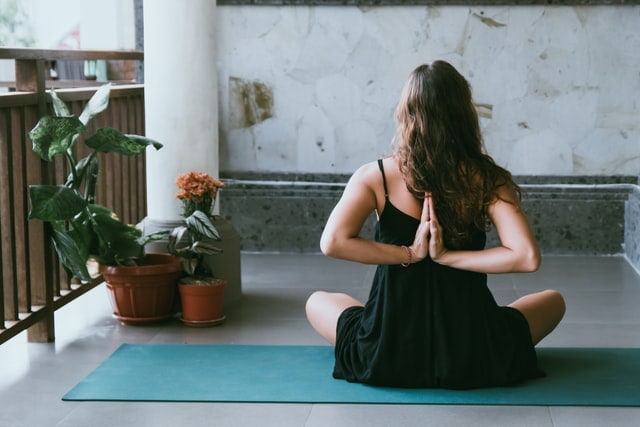
- Begin in a seated position with your spine straight.
- Reach your arms behind you and bend your elbows to join your palms behind your back.
- If your arms don’t reach behind you, place them on the floor as far behind you as you can and feel the opening in your chest.
- Push your shoulders down and away from your ears.
- Push your stretch as deep as you can and then return to a straight back.
Seated twist
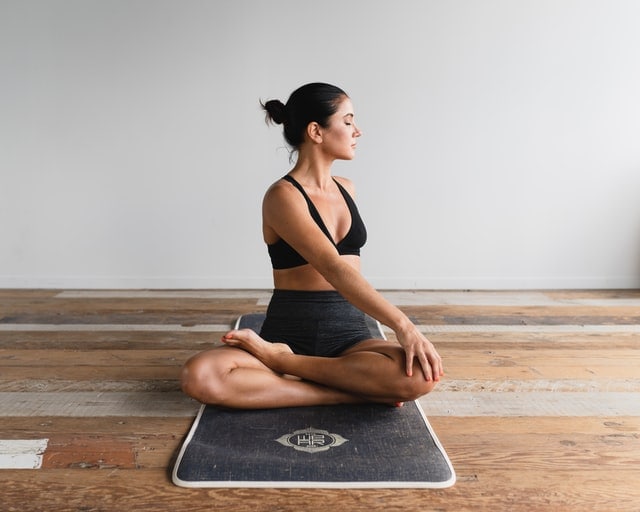
- Sit cross-legged on your mat or on a chair with your feet placed firmly on the ground.
- Place your left hand on your right knee and twist your spine to turn towards the right side.
- Make sure you are using your spine to twist and not pulling on your knee.
- Return to centre.
- Place your right hand on your left knee and twist your spine to turn towards the left side.
- Return to centre.
- Repeat five times.
Side bend
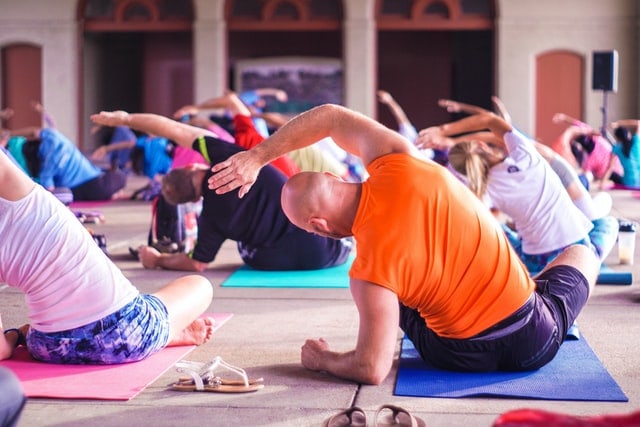
- Begin in a seated position with your spine straight.
- Place your left palm on the left side and reach your right arm up towards the sky.
- Bend your body to the left and drop your left arm so that your forearm rests on the floor, deepening the stretch on your right.
- Keep your neck soft while you do this. If you want to deepen the stretch, turn your face to look up at your right palm.
- Return to a straight back and repeat on the other side.
Child’s pose
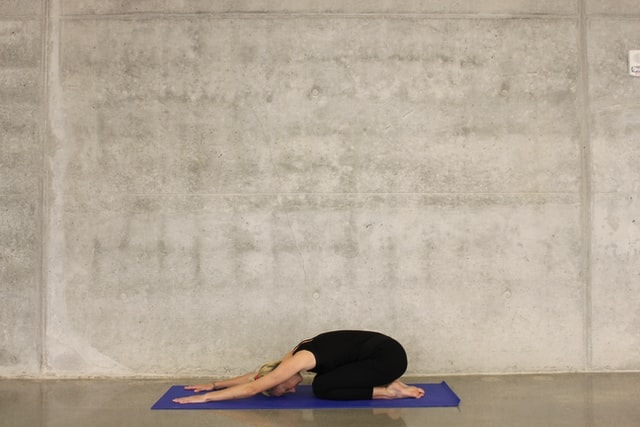
- End your stretches with this soothing pose.
- Start on all fours on the mat.
- Flatten the front of your feet to the mat and point your knees apart.
- Push your hips back to rest on your legs and fold forward over your thighs.
- Stretch your arms out alongside your body, the tops of your hands touching the floor. If you want a different stretch, stretch your arms out overhead, palms facing down on the mat.
- Place your forehead on the mat and feel the stretch in the back of your torso and shoulders.
- Hold for a minute, breathing softly.
Staying safe while doing yoga for neck and shoulders
If you are a beginner, you should remember these tips to ensure your practice for yoga for neck, shoulder and back pain is safe and effective.
- Never force your body to get into a pose. Breathe in and out, relax your body and stretch only as much as is comfortable. With time, your body will grow accustomed to the poses and you’ll find it easier.
- Aim for a minimum of 10 to 20 minutes of daily practice even if you’re doing only relaxing poses. Some amount of exercise is better than no exercise at all
- Cultivate mindfulness during your practice by observing your body during your session of yoga for neck and shoulder pain. You should know where you’re storing tension, how it feels when you stretch, and which parts of your neck or shoulders require a few extra minutes of attention that day. As mindfulness becomes a habit, you’ll be able to bring that same level of awareness to the rest of your day and be aware of your posture during work hours.
- Be adjustable and flexible in your practice. If a pose causes discomfort on some days, avoid that pose and give your body time to adapt. When doing yoga for neck pain, you may be able to work on other parts of your body like your shoulders or back to relieve stiffness and pain.
- If you are an absolute beginner, it is recommended that you join a class in one of the many yoga studios near you or sign up with a personal trainer. This gives you the necessary training so that in time you can practice on your own.
Read more in our guide to yoga for beginners.
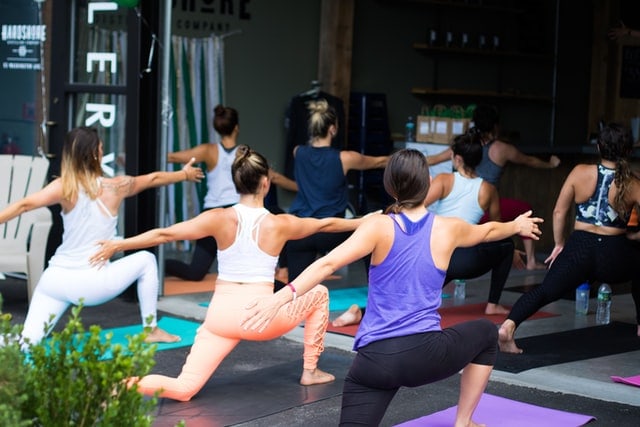
When to see a doctor for neck pain
If your neck or shoulder pain is severe, it may be necessary to see a doctor. If you notice any of the following symptoms, you should make an appointment with a doctor:
- You do not experience any pain relief from stretching or yoga
- The pain is not reducing or is getting worse over time
- There is numbness in the neck or shoulders
- You experience loss of strength in the arms or hands
- There is sharp pain between the shoulder blades or under the arm
All of these are significant concerns and you should not rely solely on poses in yoga for neck pain to deal with them. There might be serious underlying causes of these symptoms so it is best to seek medical advice. Your doctor can recommend treatment programs that should be followed or suggest physical therapy by a trained professional.



